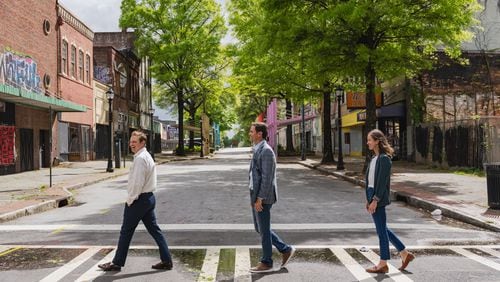Cost of immigration detention
• The taxpayer cost to detain immigrants facing deportation has more than doubled since fiscal year 2005 to $2 billion.
• Daily cost to detain an illegal immigrant: $164
• Daily cost for alternatives to detention: 30 cents to $14.
Source: Transactional Records Access Clearinghouse and the National Immigration Forum
How we got the story
To understand the full implications of the immigration bill now pending in the U.S. Senate, The Atlanta Journal-Constitution’s immigration reporter, Jeremy Redmon, analyzed the full text of the 844-page measure. To see first-hand the workings of the current detention system, Redmon worked for months to get permission to tour the privately run detention center in Gainesville with an AJC photographer.
GAINESVILLE – The hundreds of illegal immigrants locked up in the North Georgia Detention Center wear one of three colors, which instantly convey something about their past.
Men and women who have committed no serious offenses other than entering the country illegally may wear deep blue. Those convicted of crimes such as theft or drug-dealing may wear flame orange. Those guilty of violent crimes such as murder or rape wear blood red.
Regardless of uniform color, each detainee costs taxpayers — an average of $164 a day, by one informed estimate.
That price tag is one reason proponents of immigration reform support the sweeping bill now pending in the U.S. Senate. Provisions buried deep in the 844-page measure would allow more nonviolent immigrants to remain in their communities while the government attempts to deport them.
Although critics say without detention, illegal immigrants could flee.
Those sections have received less attention than the centerpiece of Senate Bill 744 — a route to citizenship for an estimated 11 million immigrants living illegally in the U.S. That provision alone could dramatically cut the number of immigrants being held behind bars.
To understand the full impact of the bill, which is expected to get a Senate vote next month, The Atlanta Journal-Constitution analyzed it in detail.
The legislation proposes alternatives to incarceration for illegal immigrants not deemed to be dangerous. Such alternatives might include supervised release, routine check-ins with immigration authorities and electronic monitoring. The bill would permit the government to contract with nongovernmental organizations that could screen and supervise illegal immigrants in their communities. In order to lock them up, it would be up to the government to show that they posed a flight risk or a threat to public safety.
Hundreds of thousands of immigrants are held behind bars nationwide each year; it's not clear how many of them the proposed changes would affect. Georgia has three privately run detention centers, located in Gainesville, Lumpkin and Ocilla. In all, there are more than 3,000 beds available for immigrant detainees in Georgia, including 188 at the Atlanta City Detention Center.
Critics worry that not incarcerating those who face deportation would allow them to abscond, which could encourage more people to come here illegally.
Jan Ting, who served as an assistant commissioner with the former U.S. Immigration and Naturalization Service, criticized the Senate bill and predicted it won’t pass.
"Not only is there an amnesty, not only is there a lifting of all the limits on immigration, but we are making the immigration enforcement system weaker by taking away the detention tool," said Ting, a professor of immigration law at Temple University and a board member of the Center for Immigration Studies. The center advocates admitting fewer immigrants.
Supporters say the Senate bill would provide more humane alternatives for people whose primary offenses are immigration violations, which are not criminal offenses. They say the changes would also save a lot of taxpayer money.
The federal government now spends $2 billion annually detaining illegal immigrants, more than double what it spent eight years ago. A report by the National Immigration Forum found the average daily cost to detain an illegal immigrant is $164, compared to between 30 cents and $14 a day for alternatives to detention.
Those alternatives "are obviously very cost-effective programs, and they are far more humane than detaining someone in a prison — and far more appropriate, too," said Donald Kerwin, who directs the New York-based Center for Migration Studies. Kerwin is the former executive director of the Catholic Legal Immigration Network.
Fredi Alcazar Dominguez, who was illegally brought to the U.S. from Mexico when he was 8, has experienced both sides of the system. In 2009 after being stopped on a traffic offense, the Mableton resident spent two months in the Stewart Detention Center in Lumpkin, more than 140 miles south of Atlanta.
He was 19 at the time, had never been behind bars before and was scared. He called it the worst experience of his life.
The government eventually deported him, but he later returned illegally so he could reunite with his family here.
Police arrested him again in December on a traffic offense, and he was turned over to federal immigration authorities. They ultimately released him but required him to check in with authorities weekly, stay out of trouble and wear an electronic monitoring bracelet on his ankle.
Now 23, Dominguez dismissed concerns that more immigrants would abscond if they are steered away from detention centers. Fleeing, he said, could jeopardize their chances of achieving their goal: legal status in the U.S.
If not locked up, he said, immigrants like himself can work and pay taxes, helping the economy grow.
“I go to the store and buy things. I use public transportation. I know I am contributing to the economy,” said Dominguez, who was allowed to shed his ankle bracelet this month after consistently complying with the terms of his supervised release.
Other illegal immigrants have gone on to break the law in Georgia after the government released them. In September 2010, for example, federal authorities arrested 32 illegal immigrants in Georgia who had committed crimes or had absconded after judges ordered them to leave the country. Thirteen had prior criminal convictions for a variety of crimes, including re-entry after deportation, drunken driving, weapons violations, assault and disorderly conduct.
To better understand the nation's immigration detention system, an AJC reporter and photographer toured the North Georgia Detention Center. Nashville-based Corrections Corporation of America operates the center, which is housed in the former Hall County jail.
The 502-bed center houses men and women, segregating them based on their gender, their criminal histories and other criteria. It had 266 detainees on the day the AJC visited, May 16, though it has been averaging 378 per day this month, said Charlie Peterson, the center’s warden. Detainees come from Georgia, South Carolina and North Carolina. Most were born in Mexico.
The place was quiet, well-lit, clean and orderly. Some of the detainees appeared resigned to their fate and somber, though several offered a friendly hello in Spanish as strangers passed.
Before it was time for them to go outside for recreation, the women detainees cooperated as authorities frisked them. When the women got outside, they huddled together, chatting quietly. Inside, the men stared blankly at television sets in their pods. The low energy in the building was palpable.
As many as 36 may share the same common living area, called a pod. They can use telephones and a law library. They also have access to a doctor and a dentist.
From the center, the detainees can be transported to the Atlanta or Columbus airports and flown back to their own countries at taxpayer cost. Those who wish to appear before an immigration judge may be transferred to detention centers in Ocilla or Lumpkin, which have courtrooms.
Last year, scores of civil and immigrant rights groups called on President Barack Obama to shut down the detention centers in Irwin and Stewart counties. They complained the two centers are located in isolated corners of the state far from immigrants’ families and attorneys.
"There is so much to be concerned about," said Anton Flores-Maisonet of Georgia Detention Watch, which watchdogs immigration detention centers, "when we trust so much of what should be public responsibility to the private sphere."
-------------------------------------------------------
Illegal immigrants detained in the U.S.
Data for fiscal years 2009 to 2011 includes detainees released on their own recognizance.
Source: U.S. Immigration and Customs Enforcement
About the Author



/cloudfront-us-east-1.images.arcpublishing.com/ajc/P7DYBH6TO7FEKG4SUXQQKADRXE.jpg)


